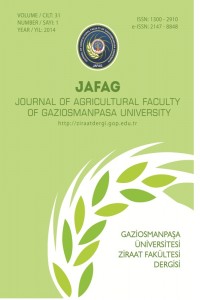Comparison of Different Interpolation Techniques For Modelling Temperatures In Middle Blacksea Region
Abstract
Objective of this study is to determine the best method for modeling and mapping monthly and annual temperatures (minimum, maximum, mean) of northern Turkey by using geographical information systems (GIS). Temperature data of 72 different meteorological observation stations were used for modeling and mapping purposes. Inverse Distance Weighting (IDW), Thin-plate smoothing spline (TPS), Simple Kriging (SK), Cokriging (CK) and Linear Regression Model (LR) were used to analyze spatial distribution of temperature data. The correlation coefficients were used to compare the methods. The data was divided in two different groups for validation procedure. The first group of data from 58 stations was used for analysis and the second group of data from 14 stations was used for testing purposes. Correlation coefficients among the estimated and measured monthly mean temperatures varied between 0.80 and 0.95. Correlation coefficients for all months were found to be significant (P < 0.01). In general, LR yielded the best results for monthly mean temperatures. While TPS was identified as the best method for monthly minimum temperatures for most of the months, LR, IDW, and CK methods yielded best results for other months. All methods yielded unsatisfactory results for maximum temperatures, especially for summer months.
Comparison of Different Interpolation Techniques For Modelling Temperatures In Middle Blacksea Region
Abstract
Objective of this study is to determine the best method for modeling and mapping monthly and annual temperatures (minimum, maximum, mean) of northern Turkey by using geographical information systems (GIS). Temperature data of 72 different meteorological observation stations were used for modeling and mapping purposes. Inverse Distance Weighting (IDW), Thin-plate smoothing spline (TPS), Simple Kriging (SK), Cokriging (CK) and Linear Regression Model (LR) were used to analyze spatial distribution of temperature data. The correlation coefficients were used to compare the methods. The data was divided in two different groups for validation procedure. The first group of data from 58 stations was used for analysis and the second group of data from 14 stations was used for testing purposes. Correlation coefficients among the estimated and measured monthly mean temperatures varied between 0.80 and 0.95. Correlation coefficients for all months were found to be significant (P < 0.01). In general, LR yielded the best results for monthly mean temperatures. While TPS was identified as the best method for monthly minimum temperatures for most of the months, LR, IDW, and CK methods yielded best results for other months. All methods yielded unsatisfactory results for maximum temperatures, especially for summer months.
Details
| Primary Language | Turkish |
|---|---|
| Journal Section | Research Articles |
| Authors | |
| Publication Date | June 1, 2014 |
| Published in Issue | Year 2014 Volume: 2014 Issue: 2 |


